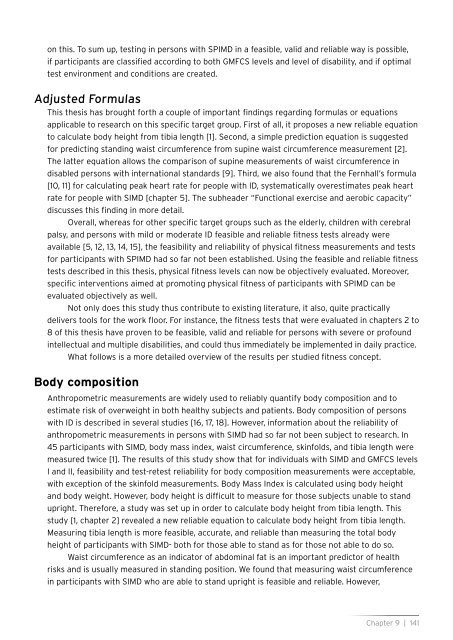Measuring physical fitness in Persons with Severe/Profound ...
Measuring physical fitness in Persons with Severe/Profound ...
Measuring physical fitness in Persons with Severe/Profound ...
- No tags were found...
Create successful ePaper yourself
Turn your PDF publications into a flip-book with our unique Google optimized e-Paper software.
on this. To sum up, test<strong>in</strong>g <strong>in</strong> persons <strong>with</strong> SPIMD <strong>in</strong> a feasible, valid and reliable way is possible,if participants are classified accord<strong>in</strong>g to both GMFCS levels and level of disability, and if optimaltest environment and conditions are created.Adjusted FormulasThis thesis has brought forth a couple of important f<strong>in</strong>d<strong>in</strong>gs regard<strong>in</strong>g formulas or equationsapplicable to research on this specific target group. First of all, it proposes a new reliable equationto calculate body height from tibia length [1]. Second, a simple prediction equation is suggestedfor predict<strong>in</strong>g stand<strong>in</strong>g waist circumference from sup<strong>in</strong>e waist circumference measurement [2].The latter equation allows the comparison of sup<strong>in</strong>e measurements of waist circumference <strong>in</strong>disabled persons <strong>with</strong> <strong>in</strong>ternational standards [9]. Third, we also found that the Fernhall’s formula[10, 11] for calculat<strong>in</strong>g peak heart rate for people <strong>with</strong> ID, systematically overestimates peak heartrate for people <strong>with</strong> SIMD [chapter 5]. The subheader “Functional exercise and aerobic capacity”discusses this f<strong>in</strong>d<strong>in</strong>g <strong>in</strong> more detail.Overall, whereas for other specific target groups such as the elderly, children <strong>with</strong> cerebralpalsy, and persons <strong>with</strong> mild or moderate ID feasible and reliable <strong>fitness</strong> tests already wereavailable [5, 12, 13, 14, 15], the feasibility and reliability of <strong>physical</strong> <strong>fitness</strong> measurements and testsfor participants <strong>with</strong> SPIMD had so far not been established. Us<strong>in</strong>g the feasible and reliable <strong>fitness</strong>tests described <strong>in</strong> this thesis, <strong>physical</strong> <strong>fitness</strong> levels can now be objectively evaluated. Moreover,specific <strong>in</strong>terventions aimed at promot<strong>in</strong>g <strong>physical</strong> <strong>fitness</strong> of participants <strong>with</strong> SPIMD can beevaluated objectively as well.Not only does this study thus contribute to exist<strong>in</strong>g literature, it also, quite practicallydelivers tools for the work floor. For <strong>in</strong>stance, the <strong>fitness</strong> tests that were evaluated <strong>in</strong> chapters 2 to8 of this thesis have proven to be feasible, valid and reliable for persons <strong>with</strong> severe or profound<strong>in</strong>tellectual and multiple disabilities, and could thus immediately be implemented <strong>in</strong> daily practice.What follows is a more detailed overview of the results per studied <strong>fitness</strong> concept.Body compositionAnthropometric measurements are widely used to reliably quantify body composition and toestimate risk of overweight <strong>in</strong> both healthy subjects and patients. Body composition of persons<strong>with</strong> ID is described <strong>in</strong> several studies [16, 17, 18]. However, <strong>in</strong>formation about the reliability ofanthropometric measurements <strong>in</strong> persons <strong>with</strong> SIMD had so far not been subject to research. In45 participants <strong>with</strong> SIMD, body mass <strong>in</strong>dex, waist circumference, sk<strong>in</strong>folds, and tibia length weremeasured twice [1]. The results of this study show that for <strong>in</strong>dividuals <strong>with</strong> SIMD and GMFCS levelsI and II, feasibility and test-retest reliability for body composition measurements were acceptable,<strong>with</strong> exception of the sk<strong>in</strong>fold measurements. Body Mass Index is calculated us<strong>in</strong>g body heightand body weight. However, body height is difficult to measure for those subjects unable to standupright. Therefore, a study was set up <strong>in</strong> order to calculate body height from tibia length. Thisstudy [1, chapter 2] revealed a new reliable equation to calculate body height from tibia length.<strong>Measur<strong>in</strong>g</strong> tibia length is more feasible, accurate, and reliable than measur<strong>in</strong>g the total bodyheight of participants <strong>with</strong> SIMD- both for those able to stand as for those not able to do so.Waist circumference as an <strong>in</strong>dicator of abdom<strong>in</strong>al fat is an important predictor of healthrisks and is usually measured <strong>in</strong> stand<strong>in</strong>g position. We found that measur<strong>in</strong>g waist circumference<strong>in</strong> participants <strong>with</strong> SIMD who are able to stand upright is feasible and reliable. However,Chapter 9 | 141











